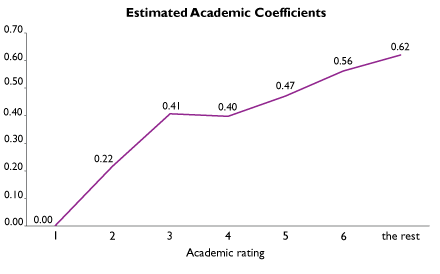Featured Faculty
Previously a member of the Strategy Department and Economics Department faculty
The college application and decision process is fraught with uncertainty, and not just for hopeful high school seniors
Colleges have their own form of admissions anxiety—they need to guess how many offers will be accepted. If too few applicants decide to attend, a college must call on its wait list. If too many accept, problems abound—dorm rooms must be reconfigured, financial aid budgets must be bolstered, and class sizes need to be reconsidered.
All admissions departments have formulas to estimate how many prospective students will matriculate each fall, and they often do quite well. Yet for all their accuracy in guessing acceptance rates, these models are not well suited to fleshing out the details of the incoming class. The simple yes-or-no number is the vital statistic, but the particulars are almost as important, including numbers relating to students who need financial aid, legacy students, and minority students.
With that in mind, three economists set out to build a better mousetrap. Using sophisticated econometric techniques, they constructed a model that evaluates the characteristics of different students and predicts the probability of each student’s accepting an offer of admission.
Morton Schapiro, president of Northwestern University, developed the model with Peter Nurnberg and David Zimmerman, professors at Williams College. Their results were highly accurate when tested against Williams’ class of 2013, although Schapiro admits the Williams admissions department’s simpler formulas arrived at nearly the same answer as their model. “There’s an old expression that goes, ‘You don’t use a tank to squash a grape,’ ” Schapiro says. “This is obviously a more sophisticated model to forecast yield than anybody uses, I think. But I’m not sure if it’s a tank.”
Individual Assessments
While the new model may be overkill for estimating straightforward yield—what admissions departments call the percentage of admitted students who accept an offer—it is well suited to determining the likelihood of any one individual’s matriculating. In the case of Williams College, students who were class valedictorians or salutatorians were 20 percent less likely to matriculate than students in the top 5 percent of their high school class.
The reason? High school seniors with top academic records tend to be admitted to more colleges, increasing their choices and decreasing the probability that they will attend any one institution. Those with slightly less glowing academic records probably have fewer choices and thus are more likely to accept an offer (Figure 1).

Figure 1. Difference in probability of accepting admission for students of different academic ratings. For example, students with an academic rating of 2 are 22 percent less likely to accept an offer than students with an academic rating of 1.
But to size up applicants, Schapiro and his colleagues’ model looks at far more than academic records and SAT scores. It also examines extracurricular activities, the distance from home to campus, the amount of contact between the student and the school, and the total financial cost to be borne by the student and their family.
“There’s an old expression that goes, ‘You don’t use a tank to squash a grape,’ ” Schapiro says. “This is obviously a more sophisticated model to forecast yield than anybody uses, I think. But I’m not sure if it’s a tank.”
According to the model, the most likely applicant to matriculate at Williams is a white male living within 10 km of campus who attends a public school. He is in the top 10 percent of his high school class and is a varsity athlete. He has a family member who attended Williams, is religious and politically active and has visited the school’s admissions office. He also has no clue what his major will be.
Some of these qualities may be a reaction to the way the school sells itself. The most likely applicant’s lack of a major is a good example. “At Williams, you can’t even declare your major until the end of your sophomore year,” Schapiro says. “It’s the way Williams portrays itself. It’s a place to go to stretch.”
Where the model says Williams College falls short is among minority applicants, those who live more than 10,000 km from campus, and those who come from a big city. Prospective students interested in art and theater are also less likely to attend Williams.
For schools that find themselves less attractive to a particular type of applicant, the model raises a few questions. In the case of art and theater students at Williams, Schapiro wonders, “Does it mean that your programs are bad, or does it mean that your programs are good and no one recognizes it?” The model could help a college determine if it needs to bolster its academic programs or simply redouble its promotional efforts in that area.
Behind the Decision
Determining why students accept an offer of admission is Schapiro’s next target. His current research focuses on what he calls “educational goodwill.” In a sense, it tries to answer the question, why would someone attend Harvard or Yale or UC Berkeley over another college, all else being equal?
“We look at everything you could possibly imagine could explain the attraction of a school,” Schapiro says. “Some schools do better than you would ever be able to explain and some schools do worse, despite the fact that they have a lot of great things going on.”
Related reading on Kellogg Insight
On the Origin of Schools: The diversity of Arizona’s charter schools
Nurnberg, Peter, Morton Schapiro, and David Zimmerman. 2012. Students Choosing Colleges: Understanding the Matriculation Decision at a Highly Selective Private Institution. Economics of Education Review, February, 31(1): 1-8.